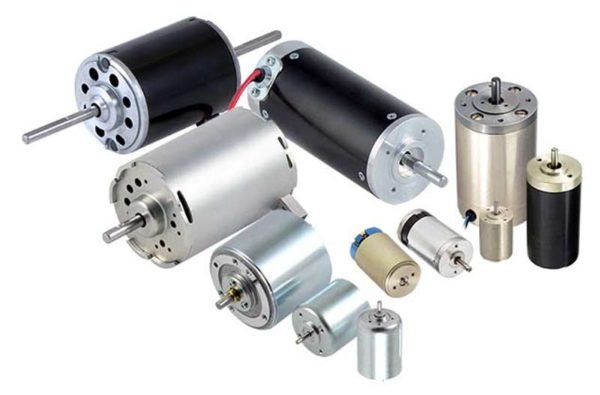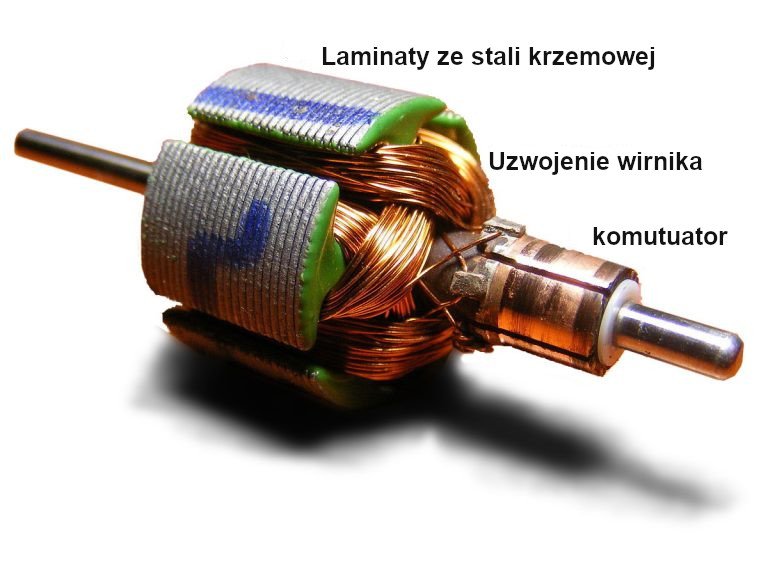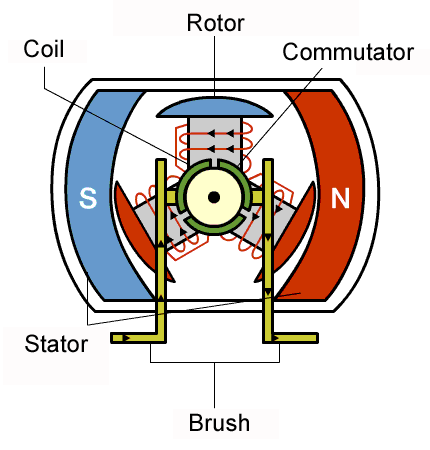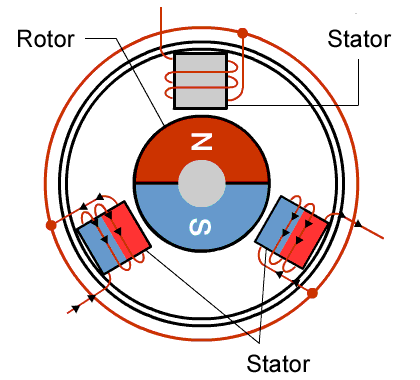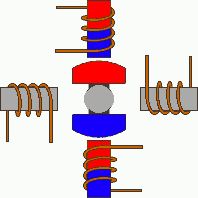Choosing the right motor - DC vs stepper motor vs servo
It's very possible that you're near at least one type of engine at the moment. They are virtually everywhere, from cameras and fans to DVD players and vibrations on your phone. There are so many of them that it's hard to choose the right engine and not miss out on some of its important parameters. With this guide, you'll find out what the differences between motors are.
Motor types
We will compare the 3 most common motor types - DC, stepper and servo. Their applications, advantages and disadvantages are taken into account here.
Brushless and brushless DC motors
DC motors are electromagnetic devices. They use the interaction between a magnetic field and an electrical conductor to convert electrical energy into mechanical energy to cause rotation. There are many types of DC motors on the market. Brushless and brushless are the most common.
Brushless DC motors
Brush DC motors have existed since the 19th century. Now they are almost everywhere - in toys, home appliances, computer fans, etc. They are very easy to build and control. So it is normal that electric brush motors are still the favorite motors of professionals and hobbyists.
DC brush motors have different sizes
(Source: Alliedmotion)
Interior of the brush motor
Why that name? Electricity is supplied by two stationary metal brushes that come into contact with different segments of the ring. During the commutator's rotation, the brushes touch each successive segment and thus continue to rotate the motor. As you can imagine, this produces a lot of friction, and therefore also heat and sometimes even sparks.
The principle of operation:
The operating diagram of the brush motor.
(Source: Renesas)
How does the electric motor move? It consists of coils connected to segments on a ring or commutator. The coils are surrounded by two magnets or a stator that surrounds the coils in the electric field. When current is transmitted by wire in the magnetic field, it experiences power. So coils in the motor also experience the power that pushes them and starts to rotate. The above GIF presents the principle of operation of a brush motor. The coil experiences a downward thrusting force when it reaches the spot on the right, and an upward thrusting force when it touches the spot on the left. Unvarying rotation can be achieved by adding several coils connected to different sections of the commutator. The direction of operation will be changed after reversing the polarity of the motor contacts.
Advantages and disadvantages:
Advantages:
- Easy to control
Control of the DC brush motor is simple. Just connect the voltage to them and they start working. They slow down when the voltage is lower, and when the voltage is reversed, they turn in a different direction.
- Excellent torque atlow rpm
High torque is achieved at low speed.
- Quite efficient
DC brush motors are 75-80 % efficient.
- Affordable
A typical DC brush motor costs only about 10 PLN.
Disadvantages
- Loud
Noise is both the result of rubbing parts and strong sparks. They are produced in places where the brushes bypass the holes in the commutator. This can cause potential interference in other parts of the system.
- Continuous maintenance
Constant movement can quickly destroy the brushes. They require constant maintenance. The speed can also be limited by the heating of the brushes.
Application:
Nowadays, some people claim that brush motors are no longer so important because, in many cases, they have been replaced by brushless motors. However, this is not true. Brushless motors may still be the best solution for many industrial equipment that requires constant torque over the entire speed range of the motor. They can be used in mobile phones (to produce vibrations), toys, portable windmills, cordless drills, car windows and many, many more. The brush motor may be a more appropriate option if you care most about a simple control system and low cost.
Brushless DC motors
Brushless DC motors are mechanically simpler than brush motors. Commutation is achieved electrically, so sparks and noise are not an option. As a result, the current change is quiet and the motor runs silently. Such silent motors are used in computer fans, disk drives, drones, electric vehicles and highly precise servos.
Brushless motor scheme.
(Source: Renesas)
The whole brushless current motor has only one moving part - the rotor. Its presence makes the complications that have been caused by the brushes in the brush motors disappear. The rotor consists of a ring of permanent magnets and the coil is stationary. This makes the brushes unnecessary. It is difficult to control the polarity of the current flowing through the coils and keep it in sync with the rotor speed. This can be achieved by measuring the electromagnetic force (SEM) or using a Hall sensor to directly measure the position of the magnet. For this reason, brushless motors, despite their many advantages, are usually more expensive and complex.
Advantages and disadvantages:
Advantages:
- Quiet
They generate less electrical noise compared to brush motors because they do not use brushes. Therefore, electric brushless motors are more often chosen when quiet motor operation is important.
- Efficient
The electric brushless motor is more efficient than the brush motor because it can continuously achieve maximum power/torque. Brush motors, on the other hand, only reach their maximum torque at a certain point during rotation. To achieve the same speed as a brushless motor, it needs a larger magnet.
- It requires less frequent maintenance
The electric brushless motor has a long service life because it has no brushes to replace.
Disadvantages:
- Controller
Some brushless motors are difficult to control and need a special controller.
Application:
Thanks to their performance and service life, brushless motors have replaced most of their equivalents with brushes. They are used in devices that work without interruption, e.g. in washing machines, air conditioners and consumer electronics (fans in computers, disk drives, etc.). Recently, they have also been used in drones, because the speed of each rotor can be precisely controlled. In the near future, we can expect that brushless motors will have more applications.
2 Stepper motors
Stepper motors run at slow and accurate speeds. They are valued for accurate position control and therefore find countless applications in stationary printers, monitoring cameras, CNC milling machines, etc.
Operating principle:
Stepper motor diagram.
(Source: emmeshop)
Stepper motors have a control system that sends electrical impulses to the controller. It in turn interprets them and sends a proportional amount of voltage to the motor. Then, the motor moves at precisely set angles. It works similarly to a brushless DC motor, except that it makes much smaller revolutions. Its only movable part is also the rotor, which consists of magnets. The polarity of each coil is controlled by alternating current. After changing it, each coil is pushed or pulled, which moves the motor.
These motors can be controlled by widely available and inexpensive microcontrollers. However, the stepper motor is a current devourer. The small steps it takes also mean that the highest speed is low and the steps can theoretically be omitted when using a heavy load.
Advantages and disadvantages:
Advantages:
- Exact positioning
Stepper motors have a large number of poles, usually between 50 and 100. The motors can move exactly between these poles without the help of a position encoder. And because they move with precise rotation, they are mostly used in devices that require precise positioning, e.g. 3D printers, CNC devices, camera platforms, X and Y plotters.
- Detailed speed control
Precise increases in motion allow excellent speed control, making these motors suitable for automation and robotics.
- Excellentlow speed torque characteristics
Stepper motors have maximum torque at low speed (below 2000 rpm). This makes them suitable for devices that do not need high speed, but require high precision. Standard electric motors and servo motors do not have such high torque at low speeds.
- Excellent torque tomaintain position
They are suitable for devices with high holding torque.
- Easily controlled
Stepper motors can be easily controlled using microcontrollers like ATmega, which are easily accessible on Arduino development boards.
Disadvantages
- Noise
Stepper motors are not quiet when they work. So, if you want your machine to be silent, to accommodate a wide range of speeds and torques, and to maintain proper performance, better choose an electric motor. But if your motion control device has to be built quickly, it doesn't have to be efficient and some noise is acceptable, then a stepper motor is more appropriate.
- Limited high speed torque
Ingeneral, stepper motors have less torque at high speeds than at lower ones. Some of these motors can be optimized so that the torque is higher at high speeds. However, to do this, the motor must be paired with the controller.
- Low performance
Unlike electric motors, the stepper motor takes the maximum current, regardless of the load. So it can overheat.
- It can skip the revolutions
The highest motor speeds are low, they can skip the rpm for high loads.
Application:
Stepper motors have different applications and are used in many common machines and equipment. They are suitable for devices requiring accurate positioning, low speed torque, and speed control. These devices include CNC milling machines, medical imaging machines, printers, monitoring cameras, 3D printers, etc.
3. servo machines
Servomechanisms are able to provide very precise motion control. Feedback, detects the difference between actual and desired speed or position. So the controller can adjust the output to improve any deviation from the target position. Positioning and constant speed are two basic types of servo motors.
Servo with Grove connector.
Working principle:
The servo consists of an electric motor. The electric motors operate at high rpm and very low torque. However, the servo motor has gears that slow down the high speed of the internal electric motor while increasing torque. In other words, the speed of the servo drive is much lower, but it has more torque. The gears are usually plastic to make the engine lighter and cheaper. But in servo motors, which have more torque, built for more difficult tasks, gears are metal.
The servo drive has a position sensor or encoder in last gear. Based on closed-circuit control, the microcontroller compares the actual and desired rotor position, and generates an error signal. This is then used to generate the appropriate control signal to place the rotor in the final position. Sophisticated servo also measures the speed needed to deliver more precise and smooth motion.
A different angle of rotation - commonly usedin small projects where moderate positioning is required. This is the most common and least expensive type of cheese. It rotates within 180 degrees. It has no speed control or constant rotation. This servo has physical interlocks built into the gear mechanism to prevent overturning beyond the limits protecting the rotary sensor.
Continuous motion servo -Unlike positioning servo, these servoes can continuously rotate clockwise and counterclockwise at different speeds, depending on the command signal.
Advantages and disadvantages
Advantages:
- Characteristics of excellent torque at high speeds
At speeds higher than 2000 rpm, servo motors have a higher torqueand are best suited for high speed and high torque applications that include dynamic load changes. These motors can produce higher peak torque because they can operate at higher speeds.
- Variety
They have different sizes and torques.
- Low cost
Small cheese costs only a dozen or so zlotys. Many of them have plastic gears to be light and cheap.
Disadvantages:
- Vibration
The servo feedback mechanism will constantly try to correct any deviation from the target position. The result of this constant adjustment will be a vibration while maintaining a stable position. If you do not want to have such a problem, choose the stepper motor.
The servo drives are used in many places, from simple toys to everyday objects and cars. They are used in remote-controlled cars to drive them. They're also used in DVD players to slide in and out discs. They're also used extensively in robotics. They come in different shapes and sizes, so you can be sure to find the right servo too.
This is the basic information you can take into account when selecting the engine. Specifications such as speed, torque, current and voltage will also help you decide which motor is right for your project, so don't forget to pay attention to the requirements. And remember that one factor will often decide many things. Knowing which motors are available and creating the parameters of your project, you can avoid costly mistakes and choose the best motor.
Are you just discovering the world of engines and not sure how to start working with them? We believe that everyone is able to build a successful electronic design and no one should be deprived of this pleasure just because they are stuck with soldering or debugging electrical circuits. For beginners we recommend the Grove kit - an easy to use plug-and-play system. Its parts can be assembled like Lego blocks, so you don't have to worry about how to use contact plates or connection wires. You can buy the set here.
We also have a wide range of DC, stepper motors and servo motors .
Source: https://www.seeedstudio.com/blog/2019/04/01/choosing-the-right-motor-for-your-project-dc-vs-stepper-vs-servo-motors/






























































































































































































































































































































